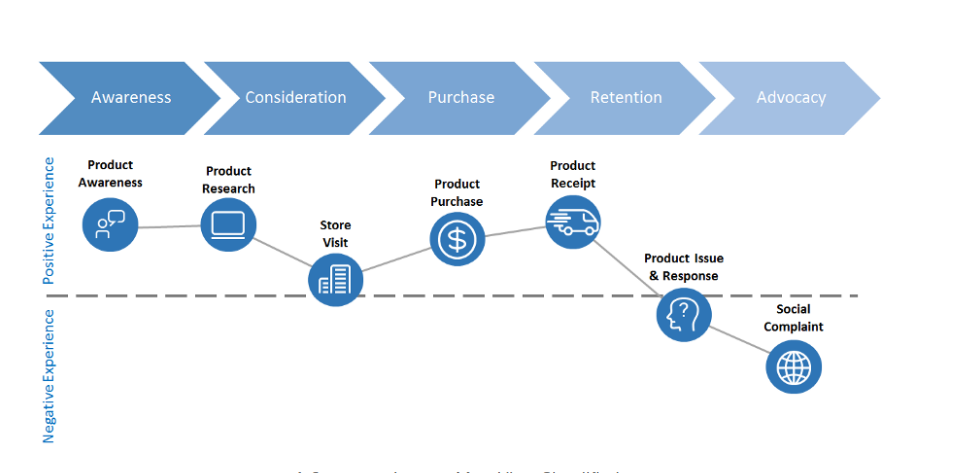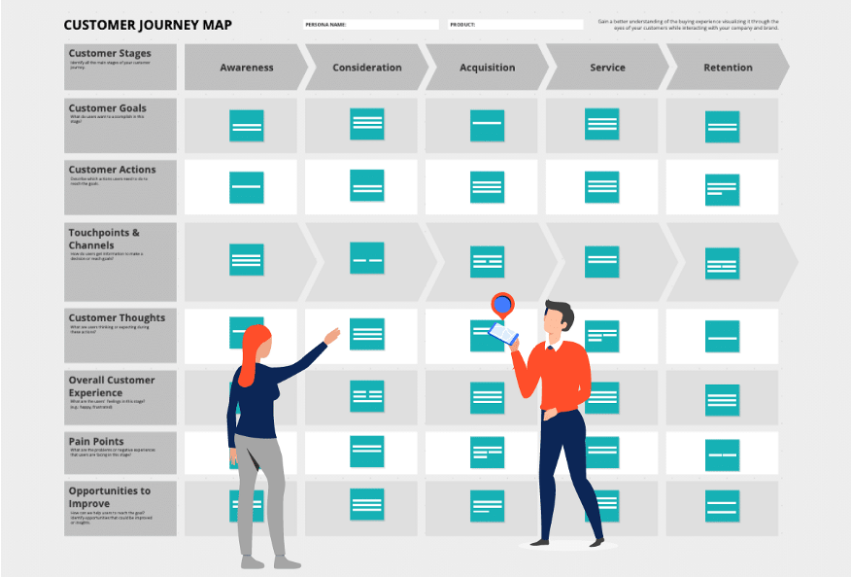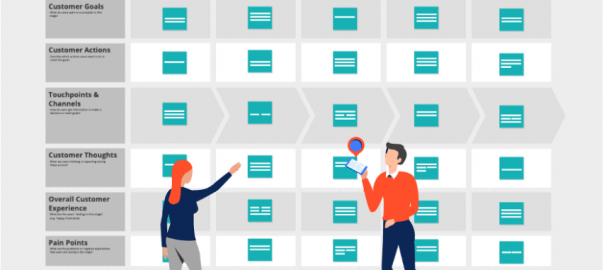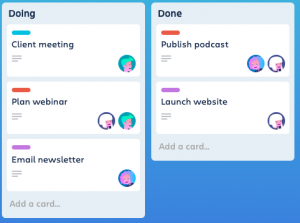As more businesses shift towards more customer-centered values and business models, customer journey mapping is quickly becoming a rising star in marketing strategy.
Customer journey mapping does not guarantee better customer engagement on its own, but it can be an essential tool for gaining a deeper understanding of your customers’ wants, needs, and expectations.
Mapping can even help you anticipate what your customer base may want in the future — what business owner doesn’t want to be more attuned to their customer’s upcoming needs?
While this trend in marketing has many applications, the customer journey map is an undoubtedly valuable tool for creating impactful email marketing campaigns.
Customer journey mapping is an unfamiliar term to many, but the premise of it is pretty simple. It is the process of understanding (a) how customers experience your brand and (b) how you can improve upon that experience.
This article will answer the fundamental questions about customer journey mapping for email marketing, including:
- What is customer journey mapping?
- Why is journey mapping important?
- How do you map the stages of the customer experience?
- How can you utilize data to map each customer’s experience?
- How can you utilize your customer journey map for email marketing?
Customer journey mapping unlocks your ability to personalize your brand experience for more customers and, in doing so, improve your business from the inside out.
In the context of email marketing, journey mapping provides you with valuable data that allows you to connect more personally with niche audiences.
What is customer journey mapping?
Customer journey mapping is a trending technique that helps business people across multiple industries — from user experience designers to business owners — visualize the journey of the customers who use their product.
More specifically, this method creates a map of your customer’s experience throughout the process of discovering, purchasing, and using your product or service.
Journey maps are designed to help you identify the weak spots or flaws in your customer experience, as well as the high points. The mapping process centers on touchpoints — the moments of interaction — with your customers and prospective customers.
Though it sounds like a complicated process, customer journey mapping is actually rather straightforward.
Essentially, mapping includes:
- Collecting user data and research
- Creating stages or steps to capture each user’s experience
- Relating every step to your goals and your customers’ goals, interactions, expectations, problems, and more
- Creating a table or graphic that expresses your customers’ experience
- Analyzing your table and data to pinpoint high and low points in your business
- Brainstorming ways to improve problems and elevate strengths
- Integrating changes based on meaningful human insights about your business and its patrons
Once you’ve taken a deep dive into the nature of your user’s experience, you can harness this newfound perspective to:
Improve your website
Customer journey mapping can help you identify sticking points in the website-user experience during touchpoints, such as:
- Using customer portals
- Booking appointments
- Searching
- Finding information
- Contacting your business
- Communicating with your business
Pinpointing the specific moments that your customers are enjoying and the moments when they may become frustrated should be of immense value to you.
You can use this data to improve your website or even build one from the ground up.
Elevate your email marketing techniques
A great way to elevate your email marketing techniques is through customer mapping.
For example, you might be working on a new email campaign plan, and you want to craft it in a way that appeals to your customers and drives them to your website. However, the number of customers that open your emails is low.
Mapping your customer journey will help you identify why they might skip your email and how to raise your email open rates with targeted content, appealing incentives, and more.
Revamp your social media strategies
If you’re looking for a way to revamp your social media strategies, mapping is the perfect place to start.
This type of visualization can help you determine why you’re lacking engagement and what content will be of more value to your customers. Ultimately, this will ensure that your time and effort is directed to posting on and monitoring the most appropriate social media channels.
Why Is Journey Mapping Important?
Gaining a deeper understanding of your customers’ journey is priceless to you as a business owner. It is the key to connecting them in the right ways at the right time. It is also vital to the relationship-building process between prospective customers and businesses.
Beyond this, journey mapping can provide you with valuable insights into why your customers behave the way they do.
In 2019, Aberdeen Group published its research on journey mapping. The findings put the importance of journey mapping into clear focus. Aberdeen’s studies revealed:
- Stronger returns on investments: Research indicates that customer mapping can lead to over 50 percent greater return on marketing investments by helping you connect with the right customers more quickly than ever.
- Vast improvements in customer service costs: Aberdeen found that mapping can help companies minimize customer service costs up to 10 times more efficiently. This improvement is driven by a decrease in customer service issues and an increase in sales.
- Striking improvements in social media engagement: Data shows that utilizing insights gained from journey mapping can lead to a more than 20% increase in positive social media interactions and mentions. In other words, mapping assures that you market to the right customers.
- A boost in customer referrals: Aberdeen found that mapping helped businesses gain 3.5 times more revenue from customer referrals through both word of mouth and social media mentions.
- Quicker sales: Journey mapping can be the catalyst to significantly faster sales. Targeting the right customers at the right time can boost your sales timelines by up to 18 times.
Overall this research indicates that customer journey mapping not only drives sales but also helps you nurture a long-lasting and meaningful connection with your customers. By unpacking the story of your customer’s journey, you will gain insights that can help you remove any obstacles between potential customers and your business.
How do you map the stages of the customer experience?
To begin mapping your customer’s experience, it is helpful to consider the five essential stages. These stages may vary in language, nature, and order depending on your business.
The five basic stages include:
1. Awareness
The first step of your customer’s journey is their discovery of a need or desire for the product or service you offer. This step also includes becoming aware of the existence of your company. This can occur via a search, recommendation, social media ad, Google ad, website, review, or social media post.
It is essential to discover how and where your loyal customers found you so that you can connect with more ideal prospects.
2. Consideration
The consideration, deliberation, or evaluation stage is the step in which your customer considers their options. They are still considering whether they will move forward with their purchase or not.
In this step, your customer may start shopping on your website, browse reviews, search your social media, and more. Here, automated emails can help persuade customers to choose you and your services. Automated emails should link to promotions or positive customer reviews to sway those prospective customers who are still undecided.
3. Acquisition
This phase includes the action of purchasing, but this stage doesn’t end with the click of the “purchase” button. Rather, this stage initiates a relationship that is built on service and communication.
From here on out, the goal is to gain a loyal customer who is happy with your services. Touchpoints in this stage may include customer discounts, automated emails, and more.
Understanding the acquisition stage will offer you valuable insights into exactly why your customers decide to choose you. Moving forward, your email campaigns should be tailored to their continued patronage via incentives and community building.
4. Retention
Once you’ve gained a new customer, retaining them is essential for maintaining the longevity of your business. This stage may include offering continued discounts or asking customers for their earnest feedback.
Keeping customers engaged and valued is the key to the retention stage.
Incentives like sneak peeks and exclusive content can help improve this stage. Mapping helps you understand why customers choose to leave or remain faithful to your brand over time.
5. Advocacy
In this stage, your customer may share their positive experience with other potential customers. Social media marketing and garnering positive reviews are important during the advocacy stage.
Keep in mind: this stage is also about ensuring that your current customers are active and engaged.
Use automation to highlight anniversaries, offer special discounts, and more. Advocacy and retention can be improved by understanding your customers’ behaviors and building strong relationships across social media platforms.

A simple example of tracking the customer journey with a user experience map from medium.com.
Ultimately, the stages of the customer journey are malleable. Choose those stages and steps that most accurately reflect your customers’ experience.
As you start mapping, gather data consistently from every stage of each customer’s unique journey with your brand.
Many companies use these stages to generate a table or graphic. Each stage should be clearly delineated on your table so that individual experiences, demographic concerns, and more can be easily applied to your map.
How can you utilize data to map your customer’s journey?
Once you have established the stages of your customer’s journey, you can begin to understand and engage with your customers by utilizing data. Harvesting the correct data can lead to behavioral insights that can improve your conversion rates, revenue, and retention.
Some of the best ways to utilize data to build your map include:
Segmentation
As the name suggests, this is the separation of your audience into segments. Segmentation can help you target specific audiences with content that is tailored to them, particularly through email marketing.
In the process of customer journey mapping, segmentation can help you understand the specific ways in which each type of user is experiencing your brand.
Moving forward, tools like segmentation allow you to utilize the insights that you have gathered on each specific audience to send emails that are crafted specifically to their wants and needs.
This reduces the risk of overloading customers with low-value content and allows you to track your customer data even more closely.
Identifying pain points
Once you have established segmented audiences, you can integrate your data to identify how you are losing customers.
For example, you might see that you are shedding younger customers after a particularly ambitious email campaign. Are you overloading them with emails? For millennial customers who utilize social media more than emails, the answer may very well be yes.
Use researched data and critical thinking to understand why your customers are taking — or not taking — action.
Pain points can also be reflected through negative feedback on social media, high volumes of customer service requests, or poor reviews.
Use customer feedback to identify where your user experience is flawed because unhappy customers are likely to look elsewhere. Use discounts and quality customer service to reconnect with unsatisfied customers.
Finding your strengths
Harnessing tools like social media metrics, email A/B testing, and email tracking can help you focus on the points in the customer experience that are gaining you customers. Place special emphasis on your loyal customers. Who are they? What are you doing right to connect with them?
Positive engagement, high click rates, and increased sales are clear signs that you have at least one stage of the customer journey that is working well for you. Capitalize on these insights!
Evaluating competition
Customer journey mapping can provide you with information that points to what your competitors are doing better than you.
Pay attention to feedback and competitor research to determine weaknesses in your customer experience. Drop-off stages can also help you identify and remove obstacles between you and your customers.

This graphic from UX Collective offers a vivid picture of some of the important customer journey elements to consider.
How can you utilize your customer journey map for email marketing?
While there is a science to building a great email marketing campaign, it is beneficial to envision your email marketing as an ongoing conversation with your customers and leads.
Consider what value you can bring to your readers through the emails you send. Customer mapping can help you determine the content to create and specific talking points that will help you connect in meaningful ways with your customers.
Keeping this in mind, there are several email marketing tools that can help you bring customer journey mapping to its full potential, including:
- Branded email templates: Once you’ve gained an understanding of which aspects of your brand appeal most to your customers, you can lean into the branding that most clearly reflects your strengths. Branded email templates make it easy to create a professional and polished brand identity in all of your correspondence.
- Automated emails: Customer journey mapping can help you add a personal touch to your email marketing, but it doesn’t have to mean more work for you! Once you’ve established the perfect content for a particular type of prospective customer, automating the email process makes it easy to ensure that emails are sent when the time is right.
- Audience segmentation: Audience segmentation is a powerful tool when paired with customer mapping. Once you’ve developed a deep understanding of your specific audience(s), you can easily tailor content and send it to the customers who will connect with it the most. This reduces the strain on your other customers’ inbox, eliminates email frustration, and provides your customers with a more personalized experience.
- Email tracking: Customer mapping can be cyclical. Using tracking tools can help you map your customer’s journey and monitor how your new insights are impacting your business. Use tracking tools to gather long-term knowledge about your customer base.
At the end of the day
It is vital to remember that the customer is the protagonist of their journey.
Mapping their experience will only help you as a business owner if you are able to look beyond the data and empathize with their human experience as your customer. Likewise, the data cannot help you without the unique human insight you bring to the table.
Customer journey mapping is equal parts analytics and critical thinking, but the most important step — by a wide margin — in customer journey mapping is placing yourself in the shoes of your customer.
Now you understand the basics of customer journey mapping. You also comprehend the ways in which you can use insights to improve your email marketing strategies.
Are you ready to create your own email journey map?
Remember, email marketing is just one piece of your marketing strategy. To learn more about how the elements of marketing come together to strengthen your business and gain lifelong customers, check out The Download, a guide to online marketing.
Digital & Social Articles on Business 2 Community
(69)
Report Post






